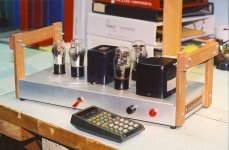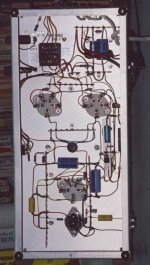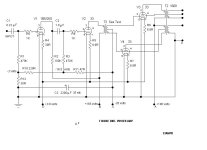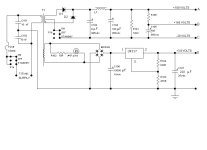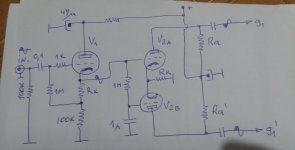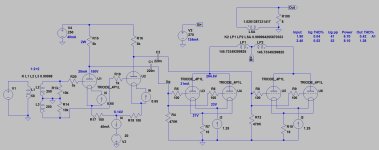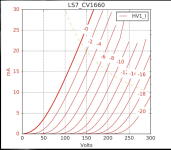The best price I found is $132 CADHopefully others will comment on whether or not the Jensens are suitable or if there are other options. I'm sure there's more to it than simply being 1:1.
I'm curious how much the 1140-LN-Cs cost in Canada, where they are made. I bought one pair from a supplier in Chicago, which had the lowest price I could find in the US, and they were just over $100 each shipped. Then Andy suggested a dealer in England and I bought some more there. The crazy thing is that the cost, including shipping from England, was ~$45 each and they arrived in two days!
I don't follow you here, John. The 124D is listed as 1:1.5. The 1140-LN-C is 1:4 or 4:1. More gain. Plus it's just a much higher quality part - nickel and studio grade. I have the 1140 and the 124B which is also part nickel and the 1140 is clearly better. The 124B is 1:3. The 124D isn't even nickel.
@andyjevans, the1140-LN-C has the CT only on the low impedance side, so you can use it as splitter only in 4:1 mode. If you want to use a concertina then the 1140-LN-A is a better choice , IMHO, but you will need a bit more gain that you can get from the 26 or similar.
In the forward direction the 1140 is 4:1, clearly step down, When turned around it does not support PP operation.The 1140-LN-C is 1:4 or 4:1.
OTOH, the H124D specs tell us 10K : 90K impedance ratio, in voltage that is 3X in the forward direction.
Depending on the source signal available, either transformer will work. But as usual, no prediction of sound
quality perceived by the user is possible.
With care in construction the result should be much more than passable.🙂👍
Problem is leakage inductance is a massive 125 mH. But it could be excellent for guitar amp use which is of my interest too.😉The amplifier sensitivity is significantly better with a Hammond 124D on the front end.
A One Volt signal at the input results in 3.5 watts audio. 👍
John: The specifications for the 124D show a frequency response of 150 HZ to 15 KHZ (+1/-3 DB) @1KHZ. Is this bandwidth performance improved by the way it is used in your schematic?Already discussed earlier in this thread, Hammond 124 Series Step Up Transformers.
Stuff it into the front end instead of the 1140, then we get plenty of signal, 👍
Yes - I only bought the 1140-LN-C because in the UK is was half price for some odd reason from KGA Enclosures, and it also does 1:4 which is what I wanted. But there are plenty of models in the 1140 range and I'd assume they are all of similar quality. It's a very good range of studio quality transformers and unjustly overlooked.@andyjevans, the1140-LN-C has the CT only on the low impedance side, so you can use it as splitter only in 4:1 mode. If you want to use a concertina then the 1140-LN-A is a better choice , IMHO, but you will need a bit more gain that you can get from the 26 or similar.
The 124 range is indeed listed as 150hz-15K and though there's more bass than that, the treble is indeed a little down compared to the 1140 range based on listening to both in the same setup.
Anyway, the 124B is 10K-to-90K CT with 49% nickel laminations. It has much better ratio between primary inductance and leakage inductance. The latter being a fraction of the 124D's anyway. It's 37 mH vs 125 mH.
The 1B5 is a DHT with a mu of 20. It’s a wimpy tube but it‘s curves a very linear. Assume 1VRMS input sensitivity, you could get a gain of approximately x15 resistively loaded, followed by a concertina you should have at least 12VRMS which is enough to drive a pair of EL84s. With the 1B5s biased at -3V you could possibly get up to or maybe more than, 25VRMS which would drive EL34s. I wouldn’t be scared of concertina’s, they operate with 100% local feedback so they’re rather transparent and with a gain of slightly less than 1 their input capacitance is low enough to mitigate the high output impedance of the lil’ 1B5.
I would consider the Sowter 3575. I have no experience with it but it looks really good and cost is the same as Hammond 1140s or better.
With 1:0.5+0.5, there are DHTs that will work fine as driver. 8x actual gain to match the 1475+type 49.
https://www.sowter.co.uk/specs/3575.php
With 1:0.5+0.5, there are DHTs that will work fine as driver. 8x actual gain to match the 1475+type 49.
https://www.sowter.co.uk/specs/3575.php
And they are microphonic, I used one in this PP 33 Amp.The 1B5 is a DHT with a mu of 20. It’s a wimpy tube but it‘s curves a very linear
Otherwise the amp is OK. 👍
Attachments
I will never consider DH triode at input stage same as input transformer , DH triode is good for some quality SET power amp , and input transformer can easy pick hum&noise ,
this simple front end never disappointed me when is used for GNFB-free PP power amps , it sounds just OK for me , it consist from one triode (v1) at input connected as cathode follower , which is actually one active impedance transformer with no voltage gain but with almost no distortion , further DC connected to differential phase inverter stage grids (V2a&V2b) , which further drives PP-OPS .
this simple front end never disappointed me when is used for GNFB-free PP power amps , it sounds just OK for me , it consist from one triode (v1) at input connected as cathode follower , which is actually one active impedance transformer with no voltage gain but with almost no distortion , further DC connected to differential phase inverter stage grids (V2a&V2b) , which further drives PP-OPS .
Attachments
only poorly made transformers. Good ones are carefully shielded. With a floating primary you also decouple the amp from the source. The transformer actually improves noise figures if well done e properly used.input transformer can easy pick hum&noise ,
Last edited:
V2 with a CCS replacing Rk works better for me. The Mullard style driver is one of my favourites in general.this simple front end never disappointed me when is used for GNFB-free PP power amps , it sounds just OK for me , it consist from one triode (v1) at input connected as cathode follower , which is actually one active impedance transformer with no voltage gain but with almost no distortion , further DC connected to differential phase inverter stage grids (V2a&V2b) , which further drives PP-OPS .
However make no mistake, good input transformers have lower distortion than any standard cathode follower. They generally use mu-metal or other high permeability cores. Maybe the cathode follower distortion becomes the same or a bit better below 30Hz which honestly is a very modest benefit.
Their phase splitting performance will never change.
Last edited:
For a colleague 45 ,
-Honestly I like more when V2- Rk is supplied from good regulated high voltage negative rail , without to use of any type of CCS ,
-Mullard style front end stage is mine favorite also , mine schematic from #74 is just mine old variation of that old Mullard concept ,
-Personally I try to avoid any transformer which transforms audio signals , even output transformers , (OTL) .
-Honestly I like more when V2- Rk is supplied from good regulated high voltage negative rail , without to use of any type of CCS ,
-Mullard style front end stage is mine favorite also , mine schematic from #74 is just mine old variation of that old Mullard concept ,
-Personally I try to avoid any transformer which transforms audio signals , even output transformers , (OTL) .
https://frank.pocnet.net/other/ServiceTypes/cv4-1/CV1166.pdf
what about this one ; amplification factor 15, anode impedance just above 4 k
what about this one ; amplification factor 15, anode impedance just above 4 k
CV1166 is an LP2 variant. It was fairly common, and about £30 to buy. Never tried it but sounds like a plausible choice.
Anyone used it?
Anyone used it?
- Home
- Amplifiers
- Tubes / Valves
- Schematic wanted for push-pull triode connected pentode amp with DHT front end

